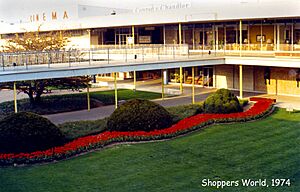Shopper's World facts for kids
| Location | Framingham, Massachusetts, United States |
|---|---|
| Coordinates | 42°18′07″N 71°23′42″W / 42.302071°N 71.395083°W |
| Address | 1 Worcester Road |
| Opening date | October 4, 1951 (Original) 1995 (Rebuilt) |
| Owner | SITE Centers Corp. |
| No. of stores and services | 26 |
| Total retail floor area | 778,476 sq ft (72,322.8 m2) |
| No. of floors | 1 |
Shopper's World is a big shopping area in Framingham, Massachusetts. It's known as a retail park, which means it has many stores that you can enter from outside. The first Shopper's World opened in 1951. It was one of the very first large shopping centers in the United States built outside of a city. This original center was later taken down and a new, modern one was built in 1995. Shopper's World and the nearby Natick Mall are both important parts of a big shopping area called the Golden Triangle.
Contents
History of Shopper's World
Shopper's World first opened its doors on October 4, 1951. It was a very new idea for shopping at the time. When it opened, it had 44 stores and welcomed 25,000 people! This new shopping center was designed to be a major place for suburban shopping between Boston and Worcester. Even today, the area is still a popular spot for shopping.
When Shopper's World first opened, the word "mall" wasn't used for enclosed shopping centers like we think of them today. Instead, people talked about its "mall" as a wide, open walkway where all the stores were located.
The Famous Jordan Marsh Dome
The original Shopper's World had a huge dome at its southern end. This dome belonged to the Jordan Marsh department store. It was the main store when the mall first opened. The dome was so big that pilots could see it from the air! It was even used on airplane maps as a landmark for planes flying into Logan Airport in Boston. People said it was the third largest unsupported dome in the world. Only St. Peter's Basilica in Rome and St. Paul's Cathedral in London were bigger.
Shopping Area Design
The original Shopper's World had two long, two-level sections of stores. These sections were separated by a large, open courtyard. Around the stores, there were huge parking lots for cars.
The design also included a theater called The Cinema. It was used for both movies and live stage shows. People who worked backstage at The Cinema even helped create the term "Best Boy" for an assistant to the chief electrician. This theater was one of the first in the country to use the large mall parking lots, which was great for people coming to evening shows. Later, The Cinema became only a movie theater and added more screens over time.
As the shopping center grew, more stores were added. A Stop & Shop grocery store and a Jordan Marsh Basement Store were built at the northern end. Even with these additions, the mall stayed open-air, meaning it didn't have a roof over the main walking areas.
Walking Around the Mall
Since there was no roof over the central part of the mall, shoppers had to walk outside to get from one store to another. To keep people dry from rain and snow, the walkways along the stores were covered by extending the store roofs. The lower walkway was protected by the top walkway. To move between the two levels, shoppers used three wide, paved ramps. Kids often loved running up and down these ramps!
Fun in the Courtyard
The open courtyard area always had interesting things happening. At the southern end, there was a permanent water fountain with colorful lights that danced to music. This "Dancing Waters" show was inspired by the fountains at the 1939 New York World's Fair. There was also a garden with seasonal flowers and picnic tables.
In the 1950s, the northern end of the courtyard had several small rides for kids. These included a mini Ferris wheel, a merry-go-round, and a boat ride. Later, a gazebo was built in this area, and ragtime and brass bands often played there.
During the holidays, Shopper's World was decorated with giant wooden soldiers and beautiful flower arrangements. Santa Claus would even visit with live reindeer every Christmas! Other special events included displays of zoo animals, like Flipper, and even spaceship rides. Car races and motorcycle riding schools also took place in the parking lot. There was even a train or tram that took customers around the mall.
The New Shopper's World
By the early 1980s, the original Shopper's World was getting old. Even though it had been very popular for many years, it hadn't changed much since it first opened.
In the early 1990s, plans were made to completely rebuild Shopper's World. The original mall closed in August 1994, and it was torn down. Many of its stores moved to the new, enclosed Natick Mall, which opened nearby in late 1994.
The new Shopper's World reopened in 1995. It's now a modern, U-shaped power center. This means it's a large outdoor shopping area with many big stores. The new Shopper's World has over 778,476 sq ft (72,322.8 m2) of shopping space. Some of the stores you can find there today include Best Buy, Starbucks, Barnes & Noble, Chipotle, Nordstrom Rack, and the first HomeSense store in the United States.
Over the years, some stores have changed. For example, the Toys "R" Us and Babies "R" Us stores closed in 2018. Later, A.C. Moore also closed its store in 2019.
|


